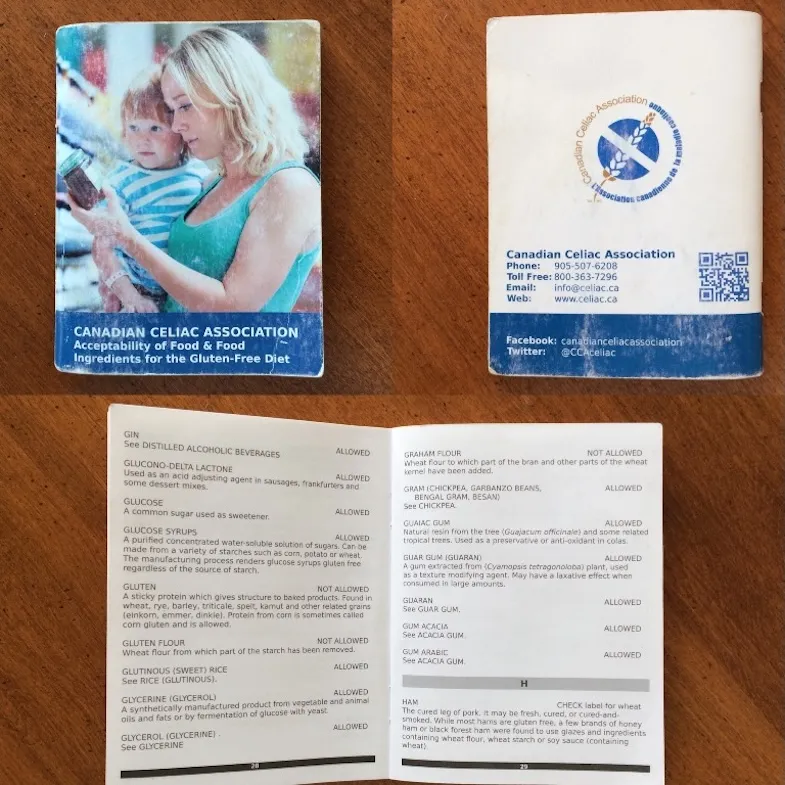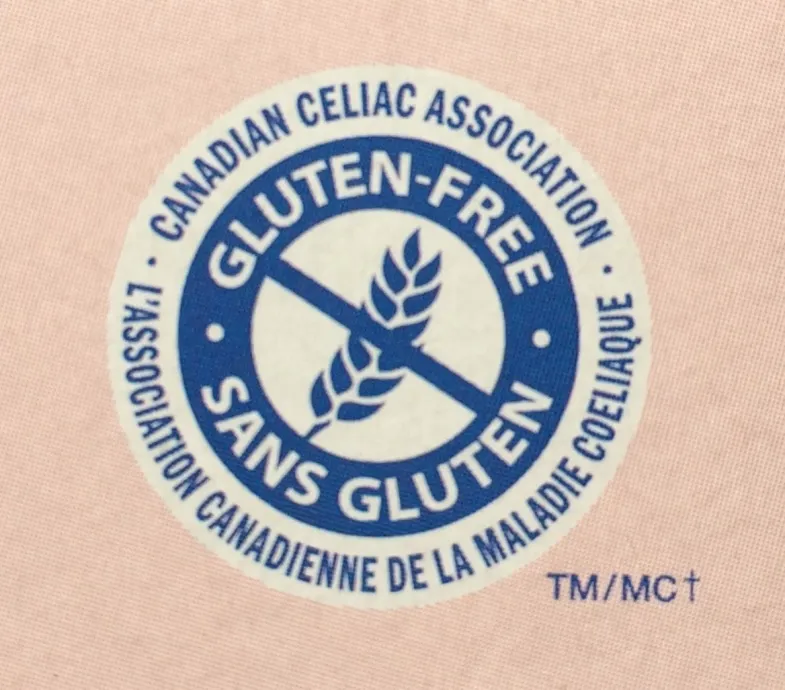Celiac Disease and Reading Labels and What Does That Canadian Celiac Association Mark on Gluten-Free Products Mean? (Updated October 3, 2024)
ShareUpdated October 3, 2024
Label reading is a fact of life after a celiac diagnosis. When I say 'label reading', I'm referring to reading the ingredients lists on products. When I was first diagnosed back in 2013, I found shopping and label reading to be overwhelming. At first I only ate whole foods like fresh vegetables, fruits and cuts of meat with no seasoning. I then received my introductory information packet from the Canadian Celiac Association, and in it was this handy little booklet listing ingredients under the categories: allowed, not allowed and check label.

Using this booklet to help read labels I slowly started to add packaged foods back into my diet. As you can see from its worn pages, I used this little booklet a lot! I also scoured the internet looking for information. I recommend that you search out and join your local celiac association. When I have any gluten/celiac related questions I usually go to their website first.
Below is a list of some of the most common foods that may contain gluten. This is by no means a comprehensive list.
- breads, cookies and other baked goods
- crackers
- pasta
- cereals
- energy bars
- coating mixes
- tortillas and other wraps
- sauces (such as soy sauce, BBQ sauces and marinades)
- gravies
- specialty and flavored vinegars (such as malt vinegar)
- soups, including broths (yes annoyingly, wheat can even be in broths)
- dressings
- some tofu and meat substitutes (seitan is a wheat gluten)
- spices
- candy and chocolate
- processed meats (bacon, sliced meat, sausages),
- oats (due to cross-contamination)
- egg dishes in restaurants (may have pancake batter added)
- any food fried in a fryer used for gluten items as the hot oil doesn't kill the gluten protein
- alcoholic drinks, such as beer
It is important to read all labels even non-food items. Many supplements and drugs could have gluten in them as a filler. I always read the label. I will speak with my pharmacist and contact the company if I'm not sure. Be careful of lipsticks and lip balm too as some do contain gluten and you could ingest gluten by licking your lips. Even some play-doughs may contain gluten and would not be safe for children with celiac disease as little ones may lick their fingers and accidentally ingest gluten. Again I don't mean to sound like a broken record, but read labels on both food and non-food items!
You can trust the food ingredients list in Canada. I begin label reading by scanning the ingredients list for these five main gluten culprits: wheat, barley, rye and oats (unless certified gluten-free they are often cross-contaminated with wheat). You can trust Canada's priority allergen and gluten labelling laws. You no longer have to look for different words for wheat such as but not limited to: semolina, spelt, einforn wheat, durum, wheat berries, emmer, farina, graham, farro, triticale, wheat starch. In Canada, products ingredient lists must have gluten sources mentioned in the ingredient list or in a contains list. Here is a great article regarding reading ingredient lists: Canadian Celiac Association - Eating Gluten Free - Reading Ingredient Lists.

Have you noticed this logo on gluten-free items yet? I have noticed it more often and wondered about it. So, I went looking and as per the Canadian Celiac Association's website it is called the GFCP (Gluten-Free Certification Program) mark. This is a voluntary certification program that companies can apply to, so that they can use it on their gluten-free products. For more information about how the program works and a list of brands that have been certified, here is a link to the Canadian Celiac Association's Gluten-Free Certification Program (GFCP) explanation page, and a link to the actual Gluten-Free Certification Program's website to find out more about the program itself.
Below are some of the products I've used that have the GFCP mark.


I have to say that seeing this mark makes me reach for the product. I guess I feel that the 'gluten-free' label is more legitimate. I still do my due diligence and read the ingredients list because I'm paranoid that way! ^_^ But seeing the mark makes me more comfortable buying the product.
I must say that it is not the only gluten-free mark I look for. Any product that has a gluten-free written on it and/or a gluten-free or wheat-free mark will get my attention as I'm always on the look out for new gluten-free products to try. But do read the ingredients list!
What are the gluten-free labelling laws like in your country? Are they easy to understand?
For more information on the Canadian Federal Governments position on gluten-free claims here are some links you can check out:
- Agriculture and Agri-Food Canada - "Gluten-Free Claims in the Marketplace
- Health Canada's Position on Gluten-Free Claims
- Canadian Food Inspection Agency Food - Labelling For Industry - Allergens and Gluten - Allergen-Free, Gluten-Free and Precautionary Statements, Gluten-Free Claims
Do you read and reread ingredients lists like I do? Were you overwhelmed when you were first diagnosed? I still find reading ingredients lists can be a challenge.
If you'd like to read a more indepth blog about "gluten-free labelling in Canada", then check out my Reading gluten-free labels in Canada blog.
Do you look for "gluten-free' logos? Does it change how you shop? Do you trust them? In Canada, at least in my area the supermarkets usually have gluten-free items both intermixed with other regular food products and a separate aisle for some gluten-free, organic items. It makes shopping time consuming. How are your gluten-free items stocked in your supermarkets? Do you have separate areas or are they mixed in with regular items?
If you are a new celiac or need to be gluten-free here is a link to the Canadian Celiac Associations Resource Page which I think is very helpful. In case the links don't work in the future here is their website : www.celiac.ca
Note: These are my personal experiences and opinions. Always seek out a medical opinion for medical concerns. Not sponsored. If sponsored I will always say so at the top of the post.